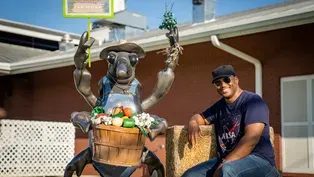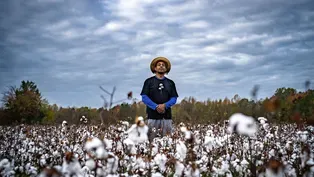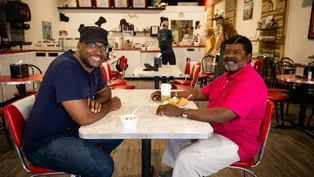
How Geology Influenced Cotton Production
Clip: Episode 6 | 3m 1sVideo has Closed Captions
Shane explores the remarkable journey that transformed the ancient Cretaceous seas.
Meet Craig McClain, the selfie-master turned biological oceanographer. While he studies tiny creatures in the ocean, he's also unraveling the secrets hidden within the rock formations. Join us as we delve into the past to understand the incredible ripple effect behind each layer of time.

How Geology Influenced Cotton Production
Clip: Episode 6 | 3m 1sVideo has Closed Captions
Meet Craig McClain, the selfie-master turned biological oceanographer. While he studies tiny creatures in the ocean, he's also unraveling the secrets hidden within the rock formations. Join us as we delve into the past to understand the incredible ripple effect behind each layer of time.
How to Watch Human Footprint
Human Footprint is available to stream on pbs.org and the free PBS App, available on iPhone, Apple TV, Android TV, Android smartphones, Amazon Fire TV, Amazon Fire Tablet, Roku, Samsung Smart TV, and Vizio.
Buy Now

Surprising Moments from Human Footprint
Do you think you know what it means to be human? In Human Footprint, Biologist Shane Campbell-Staton asks us all to think again. As he discovers, the story of our impact on the world around us is more complicated — and much more surprising — than you might realize.Quite frankly like, you know, when I look at this, honestly, I mostly just see rock.
So let's go back to about 135 million years ago.
And so we're at the beginning of the Cretaceous period.
So at this time, you know, the, the climate's warm.
And so the polar the polar ice caps are melted.
This is all what we call shallow seas.
Okay.
So the Gulf, like, extended much farther.
That's right.
Oh, very much so.
We would be a couple of hundred feet underwater.
And it was also a much warmer Earth than it is now.
Okay.
And so that caused a lot of, like plankton production in the waters near the coast.
And among those plankton were microscopic algae with calcium carbonate shells.
There's so many of them that the zooplankton that they can't eat them fast enough.
So a lot of it is just sinking to the sea floor.
Over millions of years.
Layer upon layer of those tiny shells were compressed under their own weight into chalk.
A type of limestone.
We're moving from the bottom up.
We're going from the past to the present.
That is right.
So every foot that you see there is about 18,000 years.
So if this is about 80 feet, then we're seeing about a million and a half years of of the deposition of these of these tiny plant skeletons, actually millions and billions of them.
And packed tight.
Yeah.
Over millions of years.
Over millions of years.
Okay.
Basically what we're what we're looking at is a is a massive graveyard.
It's the ghost of oceans past, essentially.
Here in Alabama, the Tombigbee river carves its way through the chalk, exposing the geology that underlies the entire black belt.
What happens here is this is so packed and so dense that it doesn't allow a water to drain out of this.
After the Cretaceous Seas retreated, this region became grasslands, and for millions of years, decomposing plants and the nutrients they contained built up on top of the chalk layer.
The result, a band of super productive soils that traces the ancient coastline.
That is what's known as the Black Belt because of these dark rich organic soils that are now at the surface and have led to a plant and crop production.
There's a lot more cotton production and it could be 10 to 20 times greater than the adjacent counties outside of this region.
And so that meant that there was more enslaved people to work those plantations in those areas.
Mm hmm.
It's kind of it's kind of hard to wrap my head around thinking about, you know, the events of African-American history being shaped by like deposits of millions of years of dead microorganisms.
That's crazy.
The planet may have set the stage for what would happen next, but the story of cotton was written by people, and the decisions they made.
Video has Closed Captions
Shane explores the Human Footprint of cotton, from ancient rocks to 21st-century politics. (30s)
Meet the 'Puff Daddy' of Cotton
Video has Closed Captions
Shane visits Julius Tillery's cotton farm to learn about the legacy behind the brand. (2m 28s)
Why the Boll Weevil is this Alabama Town's Mascot
Video has Closed Captions
Shane learns how the boll weevil became an icon in Enterprise, Alabama. (2m 36s)














